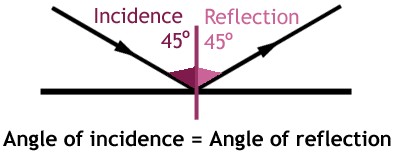

In other words, when light comes into contact with a mirror, the angle of reflection equals the angle of incidence. According to the law of reflection, light is always reflected at the same angle that it arrives at a surface. The angle between the reflected ray and the perpendicular is called the angle of reflection. The angle between the incident ray and an imaginary perpendicular line drawn to the surface of the mirror is called the angle of incidence. Reflection involves two types of light rays: the incoming, or incident, ray and the outgoing, or reflected, ray. When you look at an object in a mirror, what you see is the reflection of light from that object. Mirror, Mirror on the Wall: Angles of Reflection At the point of impact, all rays, including refracted and incident rays, are on the same interface as the normal.Molecular Expressions: Science, Optics and You - Activities in Optics - Angles of Reflection We use the degree unit to measure both the angle of incidence and the angle of refraction.Ģ. The speed of light is slowed inside the denser medium, but there is no resistance to the speed of light from any rarer media.ġ. Denser media include glass, diamonds, and kerosene.

Refraction and Dispersion of Light through a Prism.The angle of reflection is the angle formed by the surface normal and the reflected beam. The ray that depicts the light reflected by the surface is the reflected ray that corresponds to a specific incident ray. The point of incidence is the point at which a beam of light travels.Ī perpendicular line drawn from the same point is known as a normal.Ī light ray that strikes a surface is called an incident ray. The reflected ray is one that travels away from the incident ray's point of origin. The incident ray is the ray that strikes the mirror's smooth surface initially.

Here are some crucial aspects to remember when it comes to incidence angle: This article will provide you with detailed information on the angle of incidence as well as several key concepts linked to the subject. To comprehend the angle of incidence, we must first explore the notion of light reflection in depth. Angle of Incidence Meaning: The angle of incidence is defined in physics as the angle created by a ray propagating on a surface and the line normal to the point of occurrence on the same surface.


 0 kommentar(er)
0 kommentar(er)
